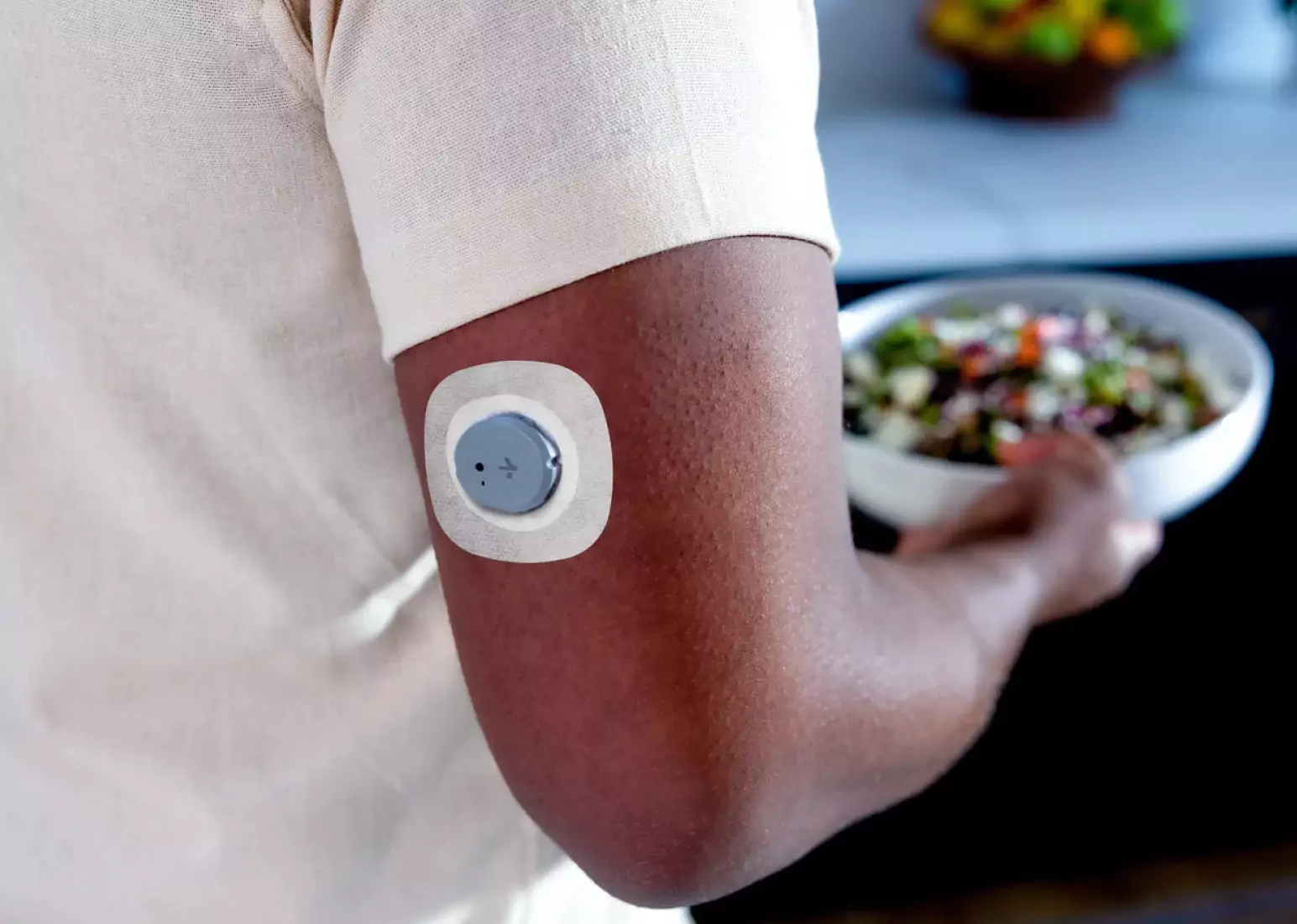4 Ways to Naturally Lower Blood Glucose Levels with CGM: A Guide

Key Takeways
Maintaining normal blood sugar levels is essential to decreasing your risk for long-term health issues, managing a healthy weight, and feeling good overall. A wide variety of health problems related to glucose level imbalances are a rapidly growing burden for the healthcare system that is reaching epidemic proportions.
Advancements in technology have made tools like continuous glucose monitoring devices more readily accessible to the every day person. This means less reliance on the healthcare system and the ability to take matters into your own hands.
You know your body best. We each have our own unique composition of genetics, diet, and lifestyle so it goes to say that our blood glucose levels react differently from one another depending on the combination of all these factors.
In this article, we'll take you through what metrics to look out for when measuring and evaluating your blood sugar levels. We'll also explain how a continuous glucose monitor helps track your data in real-time without fingerstick test strips.
What Are Normal Blood Glucose Levels?
CDC's 2021 National Diabetes Statistics Report shows some alarming statistics:
- Total: 38.4 million people have diabetes (11.6% of the U.S. population)
- Diagnosed: 29.7 million people, including 29.4 million adults
- Undiagnosed: 8.7 million people (22.8% of adults with diabetes are undiagnosed)
- Prediabetes
- Total: 97.6 million people aged 18 years or older have prediabetes (38.0% of the adult U.S. population)
- 65 years or older: 27.2 million people aged 65 years or older (48.8%) have prediabetes
With such a lack of diabetes management and awareness in the general population, it's easy for this illness to go untreated. Fortunately, there are more and more options in the market available to the public.

According to the Mayo Clinic, a normal blood sugar level is less than 140 mg/dL or 7.8 mmol/L. Blood sugar levels less than 100 mg/dL after fasting for at least eight hours are also considered normal.
If your glucose reading is greater than 200 mg/dL or 11.1 mmol/L two hours after eating a meal, the high blood sugar level could indicate diabetes. However, this will need to be verified by your doctor.
A glucose reading between 140 and 199 mg/dL (or 7.8 mmol/L and 11.0 mmol/L) could indicate prediabetes.
{{rich-text-cta-3="/style-guide"}}
Which Blood Glucose Values Really Matter?
There are three general trends that are important to understand when measuring your glucose, whether you are using a CGM or doing fingersticks. By paying attention to these different glucose trends, you'll be able to get an understanding of how you are doing and where you can improve (everyone always has room for improvement!).
1) Fasting Blood Sugar Levels
This is your glucose value when you are sleeping and without food for at least eight hours. Everyone's ideal range will be different, but a general guideline is to aim for a value of 70-90 mg/dL.
It will take some time, but focusing on trends will be very helpful here. After a few weeks of collecting data from your continuous glucose monitor, you will start to get a good idea of what your normal is. This will make it easier to identify abnormal days, such as elevated nighttime values after a night of drinking, poor sleep, or high stress.
Note: Sometimes the CGM is calibrated slightly higher or lower than true values (i.e. the values you'd get from a blood test through your doctor). Don't get too stuck on an exact fasting number. It's the trend that's the most important.
2) Peak Glucose Values

Peak glucose values are how high you "spike", which usually occurs right after a meal. Aim to to not spike above 140 mg/dL and to return to pre-meal glucose values within 2-3 hours after your meal.
It's important to consider how high the glucose goes and how quickly it comes back to normal. You want to avoid dramatic spikes and prolonged increases.
A spike every once in a while is not a big deal, but the goal is to minimize the overall occurrence and magnitude so that you don't enter into hypoglycemia or hyperglycemia.
3) Glycemic Variability
Glycemic variability refers to the "swings" in your glucose level. This trend has the greatest implications for health and is especially important to monitor.
It's normal for glucose levels to vary throughout the day, but you want to aim for these glucose "swings" to be gradual with moderate peaks, as opposed to dramatic highs and lows. So it may be possible that after a meal you only went to 130mg/dL (which is good!), but your pre-meal value was 70.
This would be quite a big swing. Look for a low standard deviation value when looking at your glucose analytics.
How Do I Naturally Lower My Blood Glucose Levels to Normal?

If you're using a continuous glucose monitor, you will have access to a large amount of real-time and historical data. As you gain a better understanding of what your glucose values and trends mean, the next step is to improve those values and get them to a healthier level.
If you have elevated blood glucose or big spikes in your glucose levels, you'll want to focus on improving the following four key factors to get back down to normal levels:
1) Nutrition
Your food choices are going to be the primary influencer on your health. This is the main pillar that simply cannot be neglected. There is no one-size-fits-all diet and many plans can fit into a healthy lifestyle.
However, everyone can benefit from reducing their intake of refined carbohydrates, added sugars, and processed foods while focusing on consuming high quality foods.
Some people may worry about consuming too many carbs and avoided high-sugar foods like bananas.
Here's an example of what happened when Kara Collier, our VP of Health, tested out some different carb sources in her diet.
"If I was craving carbs, I ate sweet potatoes because they are said to have a lower glycemic index. However, when I started using a continuous glucose monitor, I learned that my glucose response was the opposite of my initial thinking. Carbohydrate foods I thought were better for me, such as sweet potatoes, have a worse impact on me than bananas." - Kara Collier
In the glucose graphs below, you can see that eating a banana led to a minimal increase in Kara's glucose level. She also noticed that her blood sugar didn't spike when she ate foods such as beans, legumes, and berries.

2) Physical Activity
After nutrition, physical activity is the next pillar to master. Include a variety of activities in your routine including stability and mobility, weight and strength training, aerobic exercise, and anaerobic high intensity exercise.
But adequate activity doesn't stop at a hard workout. Don't underestimate the importance of daily movement and everyday activities that can count as NEAT. Limiting sedentary time is another way to make sure you're moving around and staying active.
3) Fasting & Meal Timing
Fasting can take on many forms, but experimenting with your eating schedule is a one possible way to support better glucose values. One strategy to try out is to shorten the hour range that you eat into less than 10 hours of the day.
During this period, you can shift your meals towards the beginning of the day, randomly switch up the times that you are eating, and avoid snacking. Insulin functions according to a circadian rhythm.
In general, most people experience the highest insulin sensitivity in the middle of the day, and the least insulin sensitivity in the middle of the night. In fact, insulin sensitivity peaks for most people at noon, and is 54 percent higher than insulin sensitivity at midnight.
Have a look at this experiment that Kara conducted by eating a bowl of popcorn right before bed. As you can see:
- Kara experienced an initial glucose spike around midnight.
- Her glucose levels remained high throughout the night during sleep.
- The values remained elevated until she woke up the next morning.

"Generally, if I consume popcorn during daytime hours, it will give me a small glucose spike, but then come back to normal glucose levels within two hours of eating. My nighttime glucose values are generally between 70–80 mg/dL while I sleep.
Now imagine if this was happening every night and had no idea! With the CGM providing me with a continuous stream of data, it's easier to know how to lower my blood glucose back to normal levels." - Kara Collier
4) Stress
Stress can be anything the puts the body in a physiological stressful state, which subsequently increases glucose levels. This includes mental stress, physical stress, poor sleep, and illnesses.
Elevated cortisol (the stress hormone) can drive up fasting glucose values higher than any other factor. When your cortisol levels are consistently high, the brain and liver make extra glucose and decrease your insulin sensitivity so that the excess glucose is available to treat the stress.
If this behavior is consistent over time, it dramatically increases our risk of developing chronic conditions such as type 2 diabetes. With a CGM system, you're able to visually see and quantify the effect that stress has on the body, and take action to decrease your glucose spikes.
Now, let's take a look at the effects of stress in action. In Kara's glucose graph below, you can see what a typical day looks like for her. There is some glucose variability throughout the day, but most of the time, her values range between 70–130 mg/dL.

Below, you can see Kara's glucose chart on a day where she followed a similar diet and exercise regimen, but on this day, her stress levels were very high. As you can see, this stress appears to have caused her average glucose, fasting glucose, and postprandial glucose levels to all increase significantly.

Note that it's always best to check with your healthcare professional before experimenting with your CGM.
Why Are My Fasting Glucose Values So High?
There are many different reasons why your fasting glucose values could be elevated. One factor to keep in mind is the calibration of the blood glucose monitoring device. The FDA allows CGMs to have up to a 15 percent variation versus what you would receive from a full lab draw at a physicians office.
So, your true fasting glucose value may be lower or higher than the CGM reading. The most important thing to consider is the overall glucose trend rather than an exact number. The change in glucose value using the CGM sensor is very precise and reflects real-time changes.
With that being said, below are a list of some common factors that may be causing your fasting glucose levels to rise.
1) Late Night Meals or Snacks
Both the content of your meals, portion sizes, and what time it was consumed can have an impact on fasting glucose values. Meals that are high in processed or refined carbohydrates can cause your glucose values to soar during sleep.
Additionally, the body tends to not process food as well later in the evening. This means that regardless of what you eat, any food consumption can cause glucose fasting levels to rise if you eat late at night.
2) Overall Stress Levels
Stress causes elevated cortisol levels, which leads to an increase glucose production by the liver. Under normal stressed conditions, cortisol provides the body with glucose by extracting protein stored in the liver via gluconeogenesis.
However, over the long term, elevated cortisol levels force the liver to continuously overproduce glucose, leading to increased blood sugar levels, and potentially a diabetic state.
3) Low Exercise Levels

The effect exercise has on your blood sugar levels will vary depending on how long you are active and what type of exercise you are doing. In general, physical activity makes your body more sensitive to insulin, so it can help lower your blood sugar up to 24 hours or more after working out.
When you exercise, your muscles and liver release glucose to be consumed as fuel. When you do moderate exercise for a longer time, like a hike, you body is able to use up a larger amount of glucose. This helps lower your blood sugar levels.
4) Poor Sleep Quality and/or Quantity
When you don't get enough sleep, not enough insulin is released in the body after you eat. At the same time, your body secretes more stress hormones (such as cortisol) to help you stay awake. Cortisol makes it harder for insulin to work properly, so your insulin resistance increases.
As a result, too much glucose stays in the bloodstream and your fasting glucose levels become elevated.
5) Low-Carb Diet

It's actually fairly common to experience higher fasting and nighttime glucose values if you follow a strict, very low carb/keto diet for a prolonged period of time. It appears to be a natural adaptation that the body makes to assure there is glucose present for organs that require glucose, such as the brain. (Source)
Why Do My Glucose Levels Vary So Much?
There could be several factors at play here, but in general, there is a lot of variability in glucose responses between person to person. We're all a unique compilation of genetics, epigenetics, environment, and microbiomes that cause us to react differently to the same food.
Research has shown that when you give a standardized meal to people, almost everyone has a widely different glucose response with a standard deviation of 31. Everyone’s carbohydrate tolerance is different, so that's why it's so useful to wear a CGM.
You can find out where you lie on the spectrum of general diet advice with a CGM for diet management and dietitian support from Nutrisense.
Find the right Nutrisense programto turn insight into progress.
Go Beyond Glucose Data with Nutrisense
Your glucose can significantly impact how your body feels and functions. That’s why stable levels are an important factor in supporting overall wellbeing. But viewing glucose isn't enough. Nutrisense, you’ll be able to learn how to use your body's data to make informed lifestyle choices that support healthy living.
One-to-one coaching
Sign up to access insurance-covered video calls to work with a glucose expert: a personal registered dietitian or certified nutritionist who will help tailor your lifestyle and diet to your goals.
Monitor and measure what matters
With the Nutrisense CGM Program, you can monitor your glucose with health tech like glucose biosensors and continuous glucose monitor (CGM)s, and analyze the trends over time with the Nutrisense App. This will help you make the most informed choices about the foods you consume and their impact on your health.
Find your best fit
Ready to take the first step? Start with our quiz to find the right Nutrisense program to help you take control.

Kara Collier is a registered dietitian nutritionist and certified nutrition support clinician who is passionate about reshaping how we approach prevention, behavior change, and metabolic health. A Forbes 30 Under 30 honoree, she’s helped over 150,000 people improve their metabolic health using tools like continuous glucose monitors and behavior-focused nutrition strategies. Kara has been featured by Forbes, UC Berkeley, and HLTH, and has appeared on top podcasts like Mind Pump and The Genius Life.



.png)
